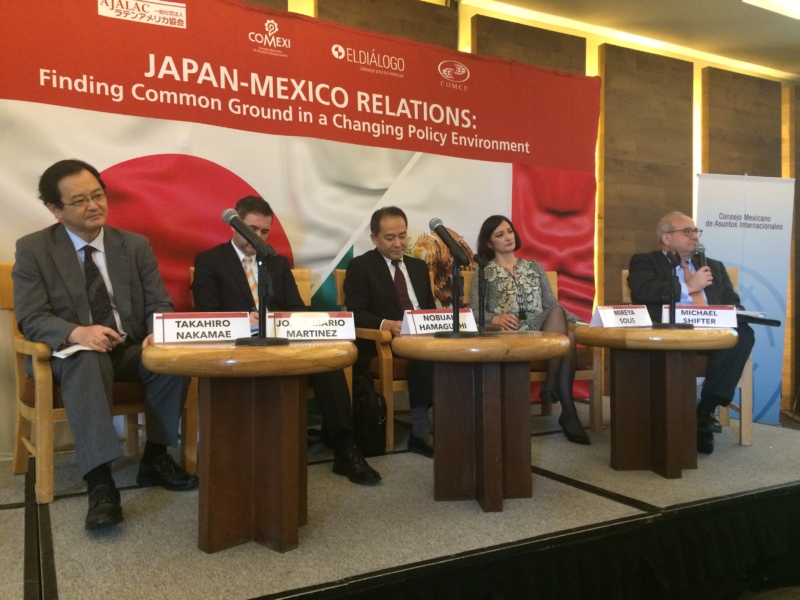Mexico: How Far Have its Institutions Really Come?
The question remains if Mexico has achieved a degree of institutional development consistent with its participation in those organizations.
On October 17, the Inter-American Dialogue, in cooperation with the Japan Association of Latin America and the Caribbean (JALAC), the Consejo Mexicano de Asuntos Internacionales (COMEXI), the Consejo Empresarial Mexicano de Comercio Exterior, Tecnología e Inversión (COMCE), and the Embassy of Japan in Mexico, held a public meeting in Mexico City to examine developments in Japan’s long-standing relationship with Mexico and other Latin American nations.
VIDEO: Welcome, Opening Remarks, and Panel Discussion
Uncertainties in the political and economic landscape in Asia and throughout the Americas are generating new challenges for both Mexico and Japan. Political change in the US, and resulting NAFTA renegotiation, are forcing Mexico to reconsider its trade and other partnerships. Following the US decision to withdraw from the Trans-Pacific Partnership, Japan is also considering the way ahead, both on trans-Pacific trade and other regional matters.
Yet, despite the climate of uncertainty, the Japan-Mexico relationship remains a source of stability and continuity, as Maria Cristina Hernández-Zermeño, keynote speaker and Director General for Asia and Oceania and Multinational Organizations at the Mexican Economy Ministry noted.
In fact, Mexico is still a key destination for Japanese firms. According to Japan’s Ambassador, Yasushi Takase, who delivered opening remarks at the meeting, over 1,100 Japanese companies are currently active in Mexico, and high rates of investment are expected in the coming years. The commercial relationship is also strengthening—trade has grown 83 percent since the signing of the Japan-Mexico Economic Partnership Agreement in 2012.
Speakers agreed that the bilateral relationship is likely to grow even more in the coming years, as both Japan and Mexico look to strengthen their global partnerships. Takahiro Nakamae, Director General of the Latin America and Caribbean Affairs Bureau of the Japanese Ministry of Foreign Affairs, described the “outstanding development” of Japanese diplomatic relations with Latin America, and a possible role for Japan as a principal interlocutor between Asia and the Latin America. In addition to Prime Minister Abe’s annual visits to the region over the past three years, the Director General mentioned Tokyo’s recent development of an inter-ministerial consultative body, which is working to enhance Japan-Latin America relations.
Both ECLAC’s Jorge Mario Martinez and Nobuaki Hamaguchi, professor at the Research Institute for Economics and Business Administration (RIEB) of Kobe University, indicated that Mexico will remain an attractive destination for the automobile sector, despite NAFTA’s uncertain future. Martinez suggested that there is considerable potential for Japan-Mexico collaboration on auto industry modernization, including incorporation of technologies and sources of energy.
Speakers also argued that in the absence of US leadership on multilateral trade in the coming years, Japan and Mexico must continue to promote trade integration, whether by backing existing agreements, engaging sub-regional platforms, such as the Pacific Alliance, or forging new trade ties. In order to stop the “tide of economic nationalism,” Brookings Institution’s Mireya Solis suggested that Japan in particular take the lead in promoting a “TPP 2.0,” a future version of the trade agreement developed by the TPP's eleven remaining partner nations. Japan, as several speakers noted, is especially well positioned to advance liberalizing trade initiatives, including rules that ensure supply chain functionality. These rules will also support the realization of other regional trade arrangements, such as Asia’s Regional Comprehensive Economic Partnership (RCEP), which in addition to the remaining TPP members, includes China, South Korea, India, and the entire ASEAN bloc. Once in force, the RCEP may also pursue new forms of integration with Latin American economies.
Sponsored by:







Supported by:
![]()
The question remains if Mexico has achieved a degree of institutional development consistent with its participation in those organizations.
Focusing on transnational crime is a top priority of the Obama administration’s policy in Latin America.
Despite reports in recent months that Mexican manufacturing is experiencing a resurgence, Mexico’s industrial sector faces tremendous challenges.
